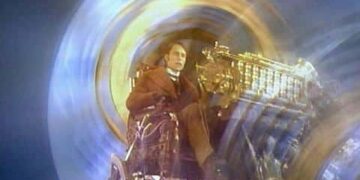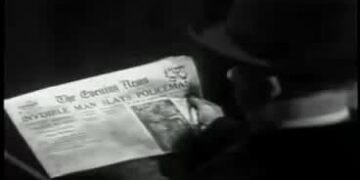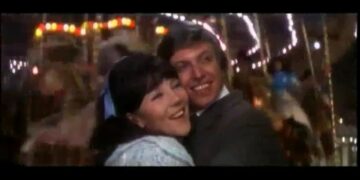Herbert George Wells, better known as H.G. Wells, is a name that resonates with literary enthusiasts and science fiction aficionados alike. Born on September 21, 1866, in Bromley, Kent, England, Wells was a prolific writer, visionary, and social commentator. His groundbreaking works, such as “The Time Machine,” “The War of the Worlds,” and “The Invisible Man,” have left an indelible mark on both literature and popular culture. As one of the pioneers of science fiction, Wells’s imagination and foresight continue to inspire and captivate audiences to this day.
H.G. Wells’s Biography: Early Life, Education, and Writing Career
H.G. Wells’s early life played a significant role in shaping his future as a writer. Growing up in a working-class family, Wells faced financial challenges but was determined to pursue his education. Despite his humble beginnings, he managed to secure a scholarship to the prestigious Royal College of Science in London, where he studied biology and geology. These scientific foundations would later become integral to his imaginative storytelling.
Wells’s writing career began in earnest with the publication of his first novel, “The Time Machine,” in 1895. This seminal work established him as a leading figure in the emerging genre of science fiction. Wells’s unique blend of scientific speculation and social commentary set him apart from his contemporaries and garnered him widespread acclaim. His subsequent novels, including “The War of the Worlds” and “The Invisible Man,” further solidified his reputation as a visionary writer.
H.G. Wells’s Impact on Cinema and Media
The influence of H.G. Wells’s works extends far beyond the realm of literature. His imaginative narratives and thought-provoking themes have inspired countless filmmakers and artists in the world of cinema and media. The iconic “War of the Worlds” has been adapted numerous times for the big screen, most notably in the 1953 film directed by Byron Haskin and the 2005 version helmed by Steven Spielberg. These adaptations not only showcase Wells’s enduring popularity but also demonstrate his ability to translate seamlessly across different mediums.
In addition to his direct impact on film, Wells’s ideas and themes have permeated popular culture in various ways. From the concept of time travel in “The Time Machine” to the notion of alien invasions in “The War of the Worlds,” his narratives have become touchstones for science fiction storytelling. Countless movies, television shows, and even video games owe a debt to Wells’s pioneering imagination. His vision of a future fraught with both wonder and danger continues to resonate with audiences worldwide.
Intriguing Tidbits: Lesser-Known Facts about H.G. Wells
Beyond his literary achievements, H.G. Wells led a fascinating life filled with intriguing tidbits. For instance, did you know that Wells predicted the invention of the atomic bomb in his novel “The World Set Free” long before its actual creation? This extraordinary foresight showcases his ability to weave fiction with reality. Furthermore, Wells’s interest in social and political matters led him to become an active member of the Fabian Society, a socialist organization that advocated for social justice and equality.
Wells’s personal relationships also shed light on his complex character. His love life and friendships were often tumultuous, and he had several failed marriages. Despite these challenges, Wells maintained close friendships with notable figures such as George Bernard Shaw and Joseph Conrad. These relationships not only influenced his writing but also provided insight into his views on society and the human condition.
Love Life and Friendships: The Personal Relationships of H.G. Wells
H.G. Wells’s love life was marked by a series of marriages and affairs that added both excitement and turmoil to his personal life. His first wife, Isabel Mary Wells, bore him two sons but the marriage ended in divorce. Wells’s second wife, Amy Catherine Robbins, also known as Jane, was his most enduring partner. They had two children together and remained married until Wells’s death.
Despite his complicated love life, Wells maintained deep friendships with several prominent writers and intellectuals. His friendship with George Bernard Shaw was particularly notable, as the two engaged in spirited debates about politics, literature, and philosophy. Wells also had a close relationship with Joseph Conrad, the acclaimed author of “Heart of Darkness.” These friendships provided Wells with intellectual stimulation and influenced his writing in profound ways.
H.G. Wells’s Financial Situation: Rich or Poor?
The question of H.G. Wells’s financial situation is a subject of much speculation. While his writing brought him considerable fame and recognition, Wells struggled with financial stability throughout his life. Despite earning substantial royalties from his books, he often found himself in debt due to extravagant spending and unsuccessful investments. Wells’s financial struggles highlight the complex reality faced by many artists and intellectuals, where commercial success does not necessarily equate to financial security.
Despite his financial challenges, Wells was a vocal advocate for social and economic equality. His experiences with both poverty and success informed his views on capitalism and socialism, and he often incorporated these themes into his writing. Wells’s own financial situation serves as a reminder of the complexities of the creative life and the pursuit of artistic expression.
Best Quotes by H.G. Wells: Insights into His Mind
H.G. Wells’s writing is replete with thought-provoking quotes that offer insight into his mind and worldview. One such quote from “The Time Machine” encapsulates Wells’s fascination with the concept of time: “There is no difference between Time and any of the three dimensions of Space except that our consciousness moves along it.” This quote highlights Wells’s ability to blend scientific theories with philosophical musings.
Another memorable quote from “The War of the Worlds” reflects Wells’s keen observation of human nature: “No one would have believed in the last years of the nineteenth century that this world was being watched keenly and closely by intelligences greater than man’s.” This quote speaks to Wells’s exploration of humanity’s vulnerability and hubris in the face of a superior alien force.
Exploring the Worlds of H.G. Wells: Main Settings of His Books
H.G. Wells’s books take readers on journeys to a variety of captivating settings. From the desolate future of “The Time Machine” to the war-torn landscapes of “The War of the Worlds,” Wells’s vivid descriptions transport readers to different worlds and times. One of his most iconic settings is the red planet Mars, which serves as the backdrop for the Martian invasion in “The War of the Worlds.” Wells’s ability to create immersive and believable settings is a testament to his imaginative prowess.
Other notable settings in Wells’s works include the underground realm of the Morlocks in “The Time Machine” and the invisible man’s adventures in the streets of London. These settings not only provide a backdrop for the narrative but also serve as metaphors for deeper societal issues. Wells’s ability to intertwine setting and theme further solidifies his status as a master storyteller.
The First and Last Books by H.G. Wells: A Journey Through Time
The first book by H.G. Wells, “The Time Machine,” marked the beginning of a literary journey that would span decades and captivate generations of readers. Published in 1895, this groundbreaking novel introduced the concept of time travel to the world and set the stage for Wells’s subsequent works. The Time Traveler’s adventures in the far future laid the foundation for the themes of social inequality and human evolution that would become hallmarks of Wells’s writing.
On the other end of Wells’s literary career is his final book, “Mind at the End of Its Tether,” published in 1945. This introspective work reflects the disillusionment and despair that Wells experienced in the twilight of his life. In it, he contemplates the decline of humanity and the potential end of civilization. “Mind at the End of Its Tether” stands as a poignant testament to Wells’s enduring curiosity and his ability to grapple with complex ideas until the very end.
The Screen Adaptation of “Half a Sixpence”: H.G. Wells’s Influence in Film
While H.G. Wells is primarily known for his science fiction works, his influence extends beyond the genre. One notable example is the screen adaptation of the musical “Half a Sixpence.” Originally a novel written by Wells, the story follows the journey of a young man who inherits a fortune and is torn between two worlds. The film adaptation, released in 1967, showcased Wells’s versatility as a writer and demonstrated the enduring appeal of his narratives.
The success of “Half a Sixpence” as a film highlights Wells’s ability to transcend genres and captivate audiences with his storytelling. It also serves as a reminder of the lasting impact he has had on popular culture in its many forms.
Other Artists Who Inspired H.G. Wells: A Collective Creative Influence
H.G. Wells’s creative genius was not solely influenced by his own imagination. Like any great artist, he drew inspiration from the works of others. One such artist who had a profound impact on Wells was Jules Verne, the French author known for his adventure novels. Verne’s imaginative storytelling and scientific themes resonated deeply with Wells and helped shape his own approach to writing.
Wells also found inspiration in the works of Mary Shelley, whose groundbreaking novel “Frankenstein” explored themes of science, morality, and the human condition. Shelley’s ability to blend the fantastical with the philosophical mirrored Wells’s own aspirations as a writer.
Must-Read Books for H.G. Wells Fans: Recommendations for Further Reading
For those who have been captivated by H.G. Wells’s writings, there are several must-read books that continue in the vein of his thought-provoking narratives. One such book is “1984” by George Orwell, a dystopian masterpiece that echoes Wells’s exploration of totalitarianism and the dangers of unchecked power.
Another recommendation is Aldous Huxley’s “Brave New World,” which presents a chilling vision of a future society controlled by technology and conformity. This novel shares Wells’s concern for the implications of scientific progress on humanity.
Buying Guide and Gift Ideas for H.G. Wells Enthusiasts: The Perfect Present
If you have an H.G. Wells enthusiast in your life, there are plenty of gift ideas to suit their tastes. For the book lover, consider a beautifully bound collection of Wells’s works, complete with insightful annotations and introductions. Alternatively, a subscription to a science fiction magazine or a membership to a book club focused on the genre would make a thoughtful gift.
For those who appreciate visual art, a framed print of a vintage “War of the Worlds” movie poster or a replica of a time machine prop would be a unique addition to their collection. Additionally, there are various merchandise items available, such as t-shirts, mugs, and posters, featuring iconic quotes and imagery from Wells’s novels.
Conclusion: H.G. Wells’s Legacy and Enduring Influence
H.G. Wells’s legacy as a visionary writer and social commentator continues to resonate with audiences worldwide. Through his groundbreaking works, he explored themes of science, society, and the human condition, leaving an indelible mark on both literature and popular culture.
From his early life and education to his enduring impact on cinema and media, Wells’s contributions have shaped the way we view the world and our place in it. His ability to blend scientific speculation with social commentary and imaginative storytelling remains unmatched.
As we delve into the worlds created by H.G. Wells, we are reminded of the power of the written word and its ability to transcend time and space. Whether through his iconic quotes, immersive settings, or thought-provoking narratives, Wells’s influence continues to captivate and inspire readers and artists alike.
So, if you’ve been enthralled by the works of H.G. Wells, take the time to explore his lesser-known facts, dive into his love life and friendships, ponder his financial situation, and discover the main settings of his books. Immerse yourself in the journey of his first and last books, appreciate his influence in film, and learn about the artists who inspired him.
And when you’re ready to further explore the world of H.G. Wells, we’ve provided a list of must-read books and gift ideas for the Wells enthusiast in your life. Embrace the enduring legacy of H.G. Wells and allow his imagination to ignite your own. The worlds he created and the ideas he explored are waiting to be discovered and cherished.
Enjoyed what you read? Show your support and fuel our fight by treating us to a coffee or purchasing captivating books of H.G. Wells on Amazon via this link.
The WFTS crew is fuelled by a fervent desire to safeguard the timeless allure of books, ensuring it never fades in the glare of the big screen.
We’re committed to presenting our work without the distraction of irrelevant and irksome banner ads.
Join us in this modern revolution to uphold the enduring magic of transmuting cherished books into Movies and TV shows













